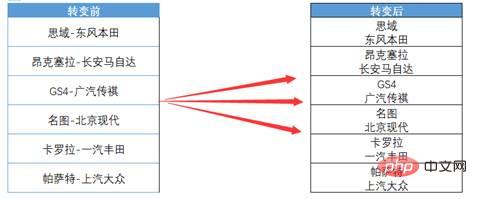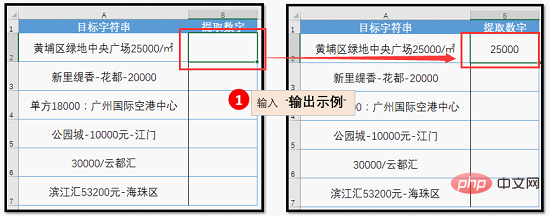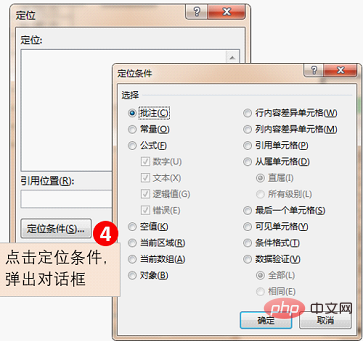Sharing practical Excel skills: Do you know how to use these 5 shortcut keys?
In the previous article " Practical Excel skills sharing: Make a dynamic inquiry form for employee information! 》, we learned about the practice of dynamic employee information query table, and today we talk about Excel shortcut keys. In fact, many operations in Excel can be completed with a shortcut key, but when I was young, I scratched my head and wrote complex function formulas to complete it. The following article will take you through 5 celebrity shortcut keys so that you will no longer take detours!

1.C position debut——Ctrl E
Ctrl E is the shortcut key for quick filling. It intelligently determines the relationship between the output result and the reference system (adjacent or non-adjacent columns) based on several output examples that have been input, and fills the cells below the output examples with the same rules based on this relationship.

For example, we want to convert a series of continuously arranged text (such as "Civic-Dongfeng Honda") into a model and manufacturer that can be filled in in separate cells. form.

# Such operation requirements, before Ctrl E, we may need to use complex nested formulas of multiple text functions to barely complete it.

PS: The formula in cell B2 in the picture is =LEFT(A2,FIND("-",A2)-1)&CHAR(10)&MID(A2 ,FIND("-",A2) 1,50), This is a nested formula with LEFT function, FIND function, CHAR function and MID function. It is not the focus of this article. Interested petals can study it by themselves.
But now, let Crrl E help you do it easily.
Operation Instructions:
Step 1 Enter "Output Example": In the first cell B2 of the output column area, fill in the content in cell A2 in separate rows ;

Step 2 Quick filling: Select the single-column area B2:B7 that needs to be filled, and click Ctrl E to complete the filling. The final effect is as follows:

Of course, Ctrl E's ability is not just as simple as arranging text, but also its special ability to extract numbers from irregular strings.

Operation Instructions:
#Step 1 Enter "Output Example": Manually input in cell B2 to enter from cell A2 The proposed number is "25000";

Step 2 Quick filling: Select the single-column area B2:B7 that needs to be filled, and click Ctrl E to complete the filling.

2. Sharp eyes——Ctrl G
Whether it is constants, formulas, or empty values, it is visible Ctrl+G can identify cells or row and column differences at a glance. Many little petals probably still don’t understand. Precise positioning is to quickly find and select all cells that contain specific types of data (such as formulas). What’s the use of it? Hehe, I don’t know. The excitement has just begun. Let me show you a batch of blank lines inserted!

Operation Instructions:
Step 1 Insert the auxiliary column, and paste the segmented standard column area as the inserted row one row apart, as shown in the picture of the province , paste A2:A14 into B3:B15;

#Step 2 Select the two columns of the same area A3:B14 before and after pasting, click Ctrl G, the [Position] dialog box will pop up box;

Step 3 Click the [Positioning Conditions] button to pop up the [Positioning Conditions] dialog box;

Step 4 Check [Row Content Difference Cells (W)] and click [OK] to complete the positioning of the difference content.

Step 5 Click [Start]-[Insert]-[Insert Worksheet Row] to complete batch insertion of empty rows;

Step 7 Then delete the auxiliary column inserted in step 1.

Why did Xiaohua choose the example of batch inserting rows to demonstrate the use of Ctrl G? This is because of its reverse operation, batch deleting blank rows is also a common Excel problem. What's more, this problem can also be solved using Ctrl G. We do this by locating the null value and then deleting the row.

Operation Instructions
Step 1 Select the column containing empty rows. It should be noted here that the column contains no empty rows except the empty rows. All valid cells are not empty;

Step 2 Press Ctrl G at the same time, select the positioning condition to be a null value, and complete the positioning of empty cells;

Step 3 Click [Start]-[Delete]-[Delete worksheet rows] to complete batch deletion of rows.

3. Bomber——Ctrl Enter
The road to growth is very bumpy, and I fight every day until I collapse. . I can't warm up my bed after get off work because I don't know Ctrl Enter. How to sum the merged cells? This is a problem we often encounter in our daily work. It is obviously a waste of time to enter formulas one by one, but we cannot drag and fill the formulas. What should we do? Let Ctrl Enter come to your rescue.

Operation instructions:
#Step 1 Select the merged cell range D2:D14 where you want to enter the sum formula, and enter the following formula
=SUM(C2:$C$14)-SUM(D3:$D$14)


Formula description:
This is a back-extrusion formula. To understand it, you need to start from the last merged cellD11 :D14Start watching.
=SUM(C11:$C$14)-SUM(D12:$D$14). Since D12, D13 and D14 are all merged invalid cells, Ctrl Enter will not fill the formula into these cells, so they are all empty cells. So the formula of D11 is equivalent to SUM(C11:$C$14), which is the real summation formula of the merged cells.
=SUM(C9:$C$14)-SUM(D10:$D$14). Since only D11 among D10:D14 is not empty, the formula of D9 is equivalent to SUM(C9:$C$14)-D11. Since D11=SUM(C11:$C$14), the formula can be further derived as SUM(C9:$C$14)-SUM(C11:$C$14), also It is equal to SUM(C9:C10), which is the real summation formula of the merged cells.
4. Paste across lines - Ctrl R
The golden combination of Ctrl C and Ctrl V can handle almost all copy and paste tasks. But once they encounter discontinuous areas, this combination becomes unable to achieve their goals. A common situation is to paste horizontally across rows after filtering. The result of Ctrl V is to paste discontinuous area values in continuous areas, destroying the original correspondence between data, leading to errors.
Operation Instructions
Step1 Select the drop-down menu in column B to filter out the lender.
Step 2 Press Ctrl to select columns C and E, copy the data source in column C, and paste the target cell in column E.

#Step 3 Press Ctrl R at the same time to complete pasting across columns. At this time, the data is pasted horizontally one by one.

#Step4 Then filter column B as debit, select the data in column C and the blank cells in column D, and press ctrl R to complete the paste.

#Step5 Finally, display all the contents of column B and you can see the following results.

5. Old trees bloom new flowers - Ctrl H
You will use find and replace ? Do you use wildcards to perform fuzzy search and replace? Would you use cell matching to accomplish exact replacement? Will you change the find and replace scope to workbook to replace all symbol conditional contents in the workbook at one go? Do you find and replace based on format? ...
If you don’t know the above functions, you may need to learn more about this familiar stranger. But if you are already proficient in these common usages, don’t be complacent, because below I will share the technique of batch format brushing of cells that meet the conditions. Are you sure you can use it?

Operation Instructions
Step 1 Select the starting cell F2, double-click the [Start] tab-Format Painter button
Step 2 Press Ctrl H, enter the search conditions, and click the [Search All] button
Step 3 In Press Ctrl A in the search results list to complete the batch format brushing.
The final effect is as follows:
Related learning recommendations: excel tutorial
The above is the detailed content of Sharing practical Excel skills: Do you know how to use these 5 shortcut keys?. For more information, please follow other related articles on the PHP Chinese website!

Hot AI Tools

Undresser.AI Undress
AI-powered app for creating realistic nude photos

AI Clothes Remover
Online AI tool for removing clothes from photos.

Undress AI Tool
Undress images for free

Clothoff.io
AI clothes remover

AI Hentai Generator
Generate AI Hentai for free.

Hot Article

Hot Tools

Notepad++7.3.1
Easy-to-use and free code editor

SublimeText3 Chinese version
Chinese version, very easy to use

Zend Studio 13.0.1
Powerful PHP integrated development environment

Dreamweaver CS6
Visual web development tools

SublimeText3 Mac version
God-level code editing software (SublimeText3)

Hot Topics
 1377
1377
 52
52
 What should I do if the frame line disappears when printing in Excel?
Mar 21, 2024 am 09:50 AM
What should I do if the frame line disappears when printing in Excel?
Mar 21, 2024 am 09:50 AM
If when opening a file that needs to be printed, we will find that the table frame line has disappeared for some reason in the print preview. When encountering such a situation, we must deal with it in time. If this also appears in your print file If you have questions like this, then join the editor to learn the following course: What should I do if the frame line disappears when printing a table in Excel? 1. Open a file that needs to be printed, as shown in the figure below. 2. Select all required content areas, as shown in the figure below. 3. Right-click the mouse and select the "Format Cells" option, as shown in the figure below. 4. Click the “Border” option at the top of the window, as shown in the figure below. 5. Select the thin solid line pattern in the line style on the left, as shown in the figure below. 6. Select "Outer Border"
 How to filter more than 3 keywords at the same time in excel
Mar 21, 2024 pm 03:16 PM
How to filter more than 3 keywords at the same time in excel
Mar 21, 2024 pm 03:16 PM
Excel is often used to process data in daily office work, and it is often necessary to use the "filter" function. When we choose to perform "filtering" in Excel, we can only filter up to two conditions for the same column. So, do you know how to filter more than 3 keywords at the same time in Excel? Next, let me demonstrate it to you. The first method is to gradually add the conditions to the filter. If you want to filter out three qualifying details at the same time, you first need to filter out one of them step by step. At the beginning, you can first filter out employees with the surname "Wang" based on the conditions. Then click [OK], and then check [Add current selection to filter] in the filter results. The steps are as follows. Similarly, perform filtering separately again
 How to change excel table compatibility mode to normal mode
Mar 20, 2024 pm 08:01 PM
How to change excel table compatibility mode to normal mode
Mar 20, 2024 pm 08:01 PM
In our daily work and study, we copy Excel files from others, open them to add content or re-edit them, and then save them. Sometimes a compatibility check dialog box will appear, which is very troublesome. I don’t know Excel software. , can it be changed to normal mode? So below, the editor will bring you detailed steps to solve this problem, let us learn together. Finally, be sure to remember to save it. 1. Open a worksheet and display an additional compatibility mode in the name of the worksheet, as shown in the figure. 2. In this worksheet, after modifying the content and saving it, the dialog box of the compatibility checker always pops up. It is very troublesome to see this page, as shown in the figure. 3. Click the Office button, click Save As, and then
 How to type subscript in excel
Mar 20, 2024 am 11:31 AM
How to type subscript in excel
Mar 20, 2024 am 11:31 AM
eWe often use Excel to make some data tables and the like. Sometimes when entering parameter values, we need to superscript or subscript a certain number. For example, mathematical formulas are often used. So how do you type the subscript in Excel? ?Let’s take a look at the detailed steps: 1. Superscript method: 1. First, enter a3 (3 is superscript) in Excel. 2. Select the number "3", right-click and select "Format Cells". 3. Click "Superscript" and then "OK". 4. Look, the effect is like this. 2. Subscript method: 1. Similar to the superscript setting method, enter "ln310" (3 is the subscript) in the cell, select the number "3", right-click and select "Format Cells". 2. Check "Subscript" and click "OK"
 How to set superscript in excel
Mar 20, 2024 pm 04:30 PM
How to set superscript in excel
Mar 20, 2024 pm 04:30 PM
When processing data, sometimes we encounter data that contains various symbols such as multiples, temperatures, etc. Do you know how to set superscripts in Excel? When we use Excel to process data, if we do not set superscripts, it will make it more troublesome to enter a lot of our data. Today, the editor will bring you the specific setting method of excel superscript. 1. First, let us open the Microsoft Office Excel document on the desktop and select the text that needs to be modified into superscript, as shown in the figure. 2. Then, right-click and select the "Format Cells" option in the menu that appears after clicking, as shown in the figure. 3. Next, in the “Format Cells” dialog box that pops up automatically
 How to use the iif function in excel
Mar 20, 2024 pm 06:10 PM
How to use the iif function in excel
Mar 20, 2024 pm 06:10 PM
Most users use Excel to process table data. In fact, Excel also has a VBA program. Apart from experts, not many users have used this function. The iif function is often used when writing in VBA. It is actually the same as if The functions of the functions are similar. Let me introduce to you the usage of the iif function. There are iif functions in SQL statements and VBA code in Excel. The iif function is similar to the IF function in the excel worksheet. It performs true and false value judgment and returns different results based on the logically calculated true and false values. IF function usage is (condition, yes, no). IF statement and IIF function in VBA. The former IF statement is a control statement that can execute different statements according to conditions. The latter
 Where to set excel reading mode
Mar 21, 2024 am 08:40 AM
Where to set excel reading mode
Mar 21, 2024 am 08:40 AM
In the study of software, we are accustomed to using excel, not only because it is convenient, but also because it can meet a variety of formats needed in actual work, and excel is very flexible to use, and there is a mode that is convenient for reading. Today I brought For everyone: where to set the excel reading mode. 1. Turn on the computer, then open the Excel application and find the target data. 2. There are two ways to set the reading mode in Excel. The first one: In Excel, there are a large number of convenient processing methods distributed in the Excel layout. In the lower right corner of Excel, there is a shortcut to set the reading mode. Find the pattern of the cross mark and click it to enter the reading mode. There is a small three-dimensional mark on the right side of the cross mark.
 How to insert excel icons into PPT slides
Mar 26, 2024 pm 05:40 PM
How to insert excel icons into PPT slides
Mar 26, 2024 pm 05:40 PM
1. Open the PPT and turn the page to the page where you need to insert the excel icon. Click the Insert tab. 2. Click [Object]. 3. The following dialog box will pop up. 4. Click [Create from file] and click [Browse]. 5. Select the excel table to be inserted. 6. Click OK and the following page will pop up. 7. Check [Show as icon]. 8. Click OK.








